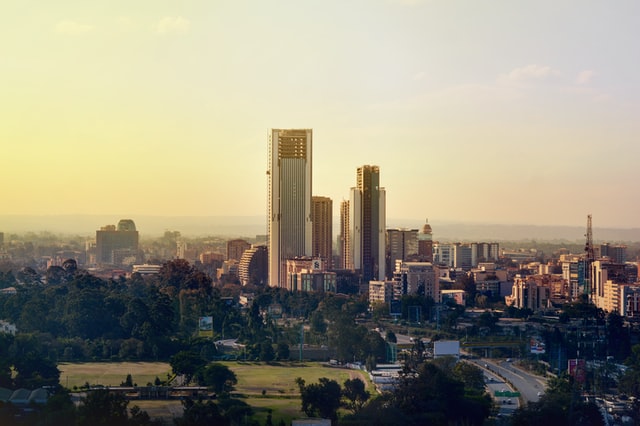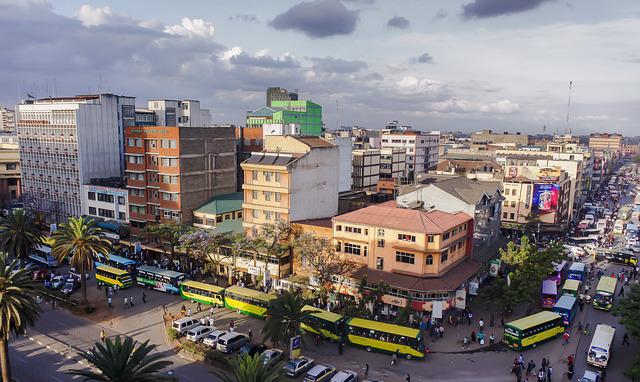Nairobi
Introduction
Nairobi, the capital and largest city of Kenya, is located in the south-central part of the country at an elevation of approximately 1,680 metres (5,500 feet). The city’s name is derived from the Maasai phrase "Enkare Nairobi," which translates to "cool water," referencing the Nairobi River that flows through it. Nairobi lies about 480 kilometres northwest of Mombasa, Kenya’s primary port on the Indian Ocean.
Founded in the late 1890s, Nairobi began as a colonial railway settlement during the construction of the Uganda Railway. In 1899, the British colonial capital of Ukamba province was relocated from Machakos to Nairobi. By 1905, the city had become the capital of British East Africa, eventually developing into a vital trading hub. A small Indian bazaar emerged around 1900, contributing to Nairobi's role as a commercial centre. The city's growth continued through the 20th century, becoming a key economic, political, and transportation centre in East Africa. Nairobi was declared a municipality in 1919 and granted city status in 1954. After Kenya gained independence in 1963, Nairobi remained the capital.
Nairobi is a major transportation hub, with roads and railways connecting it to key regions. The main routes link Nairobi to Mombasa, Tanzania, Uganda, and Lake Victoria. The city is served by Jomo Kenyatta International Airport, located 15 kilometres to the southwest, which is one of the largest airports in Africa. Nairobi also has a commuter rail system that connects its suburbs with the city centre, helping to ease traffic congestion.
Nairobi is home to key institutions, such as the Kenyan Parliament Buildings and the headquarters of several international organisations, including the United Nations Environment Programme (UNEP) and the United Nations Office at Nairobi (UNON). The Nairobi Securities Exchange (NSE) is one of Africa’s largest stock exchanges. The city is also a cultural hub, hosting a variety of museums, theatres, and parks. Nairobi National Park, located on the city’s southern outskirts, is a notable tourist attraction, known for its wildlife and proximity to urban areas.
Nairobi’s economy is diverse, including sectors such as manufacturing, technology, and tourism. In recent years, it has witnessed significant infrastructure development, including the completion of the Nairobi Expressway and housing projects under the government’s Affordable Housing Program to accommodate the city's growing population.

Data and facts
Administration
Nairobi holds the status of a full administrative county in Kenya. It is unique compared to other regions in Kenya because it is entirely urban, unlike other counties that have both rural and urban areas. Nairobi County is governed by the Nairobi City County government, which replaced the former Nairobi City Council after the implementation of the new constitution in 2010.
Before 2007, Nairobi was not divided into districts, but three districts were created in that year. Following the 2010 constitution, Nairobi was formally recognised as a county. As of 2024, Nairobi County is divided into 17 constituencies, each represented in the National Assembly by a Member of Parliament. These constituencies are sometimes named differently from their corresponding administrative divisions. For example, Starehe Constituency corresponds to the Central Division, Lang'ata Constituency covers parts of the Kibera Division, and Kamukunji Constituency aligns with the Pumwani Division.
Nairobi's administrative structure allows it to function both as a city and a county, managing its urban governance under one centralised system. The Governor of Nairobi is the top executive, responsible for overseeing the county's development, services, and infrastructure. Nairobi's status as a county enables it to focus on urban challenges such as transportation, housing, and public services, which are particularly important due to its large and growing population.
Economy
Kenya remains the most vibrant economy in East Africa, with Nairobi as the country’s main commercial hub. Nairobi has a well-developed infrastructure that supports modern financial services, communications, and trade. Major domestic banks, such as Kenya Commercial Bank (KCB), and international banks like Barclays, Citibank, and Standard Chartered operate from the city, making it a key financial centre in the region.
Nairobi is also the largest industrial centre in Kenya. The city's industrial base contributes significantly to the country’s economy, producing a wide range of goods, including processed food, beer, vehicles, construction materials, soaps, textiles, and chemicals. These industries account for around 20 percent of Kenya’s gross domestic product (GDP). Additionally, the informal sector in Nairobi thrives, providing employment to many artisans such as carpenters, metal workers, furniture makers, vehicle repairers, and small-scale retailers.
Agriculture remains the backbone of Kenya’s economy, employing nearly 80 percent of the population. It contributes 29 percent to the GDP and generates over 50 percent of the country’s export earnings. The regions surrounding Nairobi consist of prime agricultural lands. Key food crops grown in these areas include maize, sorghum, cassava, beans, and various fruits. Coffee, a major cash crop, is cultivated by small-scale farmers.
Horticulture has also become a significant growth sector, with flower exports contributing greatly to Kenya's foreign exchange earnings. The country is one of the world’s largest exporters of cut flowers, and Nairobi serves as the central hub for this booming industry.
In recent years, Nairobi has also seen growth in its technology and innovation sectors. It is home to a growing number of tech startups and is often referred to as the "Silicon Savannah." This tech hub contributes to Kenya's digital economy and attracts investment from international companies looking to expand in Africa. Additionally, Nairobi’s service sector, which includes finance, real estate, and tourism, plays a vital role in driving the city's economic growth.
Infrastructure
In 2024, Nairobi continues to experience significant infrastructure development as part of Kenya’s broader national plans. The Nairobi Metropolitan Area Infrastructure Report, first released in 2018, highlighted the distribution, supply, stock, deficits, and investment opportunities in the region’s infrastructure sector. Since 2012, the Government of Kenya has invested heavily in infrastructure, with investments amounting to Kshs 4.2 trillion by 2024.
The energy sector has received the largest share of this investment, totalling Kshs 1.8 trillion, or about 42.5% of the total funds. A major portion of this funding has gone into expanding geothermal power generation, as well as initiatives like the Last Mile Connectivity Program and the Rural Electrification Program, which aim to increase access to electricity across the country. These projects have greatly improved energy distribution and reduced the electricity deficit in Nairobi and its surrounding areas.
Road infrastructure continues to dominate in terms of the number of completed and ongoing projects, making up around 68% of all infrastructure projects. Major road projects include the Nairobi Expressway, which was completed in 2022 and has significantly reduced traffic congestion along Mombasa Road, and the construction of new bypasses and interchanges to improve urban mobility. The expansion of key highways, such as the Outer Ring Road, has also made it easier to access different parts of the city and connect Nairobi to other major towns.
In addition to roads and energy, the government has made investments in water supply, sanitation, and transport infrastructure. The Green Park Bus Terminal, which started operations in 2021, is part of efforts to modernise public transport in Nairobi. Plans to expand the commuter rail network are also in progress, aimed at easing congestion and improving transport efficiency in the city.
These infrastructure projects have opened up new investment opportunities in real estate, manufacturing, and technology, as Nairobi continues to grow as a hub for business and trade in East Africa. The government’s focus on infrastructure development is expected to drive economic growth and improve the quality of life for residents in the coming years.

Technology
Nairobi continues to be a major hub for technology and innovation in Africa. The Nairobi Securities Exchange (NSE), one of Africa’s largest stock exchanges, remains a key financial institution. Recognised as an overseas stock exchange by the London Stock Exchange since 1953, the NSE ranks as Africa’s 4th largest in terms of trading volumes and 5th largest by market capitalisation as a percentage of GDP.
The city serves as the regional headquarters for several global companies. Since 2007, international giants like General Electric, Google, Coca-Cola, IBM Services, and Cisco Systems have established their African headquarters in Nairobi. The United Nations Office at Nairobi (UNON) also hosts the headquarters for UN Environment and UN-Habitat, further cementing Nairobi’s position as a key international centre.
Nairobi is home to some of Africa's largest companies, including Safaricom, the most profitable company in Kenya, and KenGen, the largest energy producer in East Africa. Nairobi also serves as the hub for Kenya Airways, Africa’s fourth-largest airline, with Jomo Kenyatta International Airport playing a central role in connecting Africa to the world.
Nairobi’s technology sector, often referred to as "Silicon Savannah," has seen rapid growth, particularly in financial technology (FinTech). The city has produced several tech firms that are making waves in Kenya and beyond. Companies like Craft Silicon, Jambo Pay, and Kangai Technologies are leaders in cloud-based computing services and digital payments. These firms have developed products that are widely used across Kenya, providing innovative solutions for businesses and consumers.
The rise of mobile money, driven by services like M-Pesa, has further boosted Nairobi's reputation as a FinTech leader. In recent years, Nairobi has become a centre for digital innovation, attracting tech startups and investors from around the world. The city is also a key player in blockchain technology, with various pilot projects and startups exploring the potential of blockchain for sectors like finance, healthcare, and supply chain management.
As of 2024, Nairobi continues to attract investment in its tech sector, with new initiatives supporting digital infrastructure, tech education, and entrepreneurship. This has helped solidify the city’s status as one of Africa’s most important technology and innovation hubs.
References
- Nairobi| Wikipedia
- Nairobi | History, Population, Map, & Facts| Britannica
- Nairobi City County: Home| Nairobi City County
- Nairobi, Kenya - Tourist Places & Top Things to Do in 2024| MakeMyTrip
- University of Nairobi | Committed to Scholarly Excellence| University of Nairobi
- Nairobi Tourism: All You Need to Know Before | Tripadvisor
- United Nations Office at Nairobi | United Nations Office at Nairobi
- Nairobi International Convention on the Removal of Wrecks| IMO.org
- Explore Nairobi| Nairobi City County
- Kenya| Wikipedia
- Welcome to High Commission of India Nairobi, Kenya| High Commission of India Nairobi
- U.S. Embassy in Kenya: Homepage| U.S. Embassy in Kenya (.gov)
- Nairobi eServices Portal: Nairobi Pay| Nairobi eServices Portal
- Nairobi Summit| Nairobi Summit
- Nairobi Treaty on the Protection of the Olympic Symbol| World Intellectual Property Organization (WIPO)
- Nairobi - Careers| Google
- Nairobi City Water and Sewerage Company: Home| Nairobi City Water and Sewerage Company
 Metricsbeta
Metricsbeta